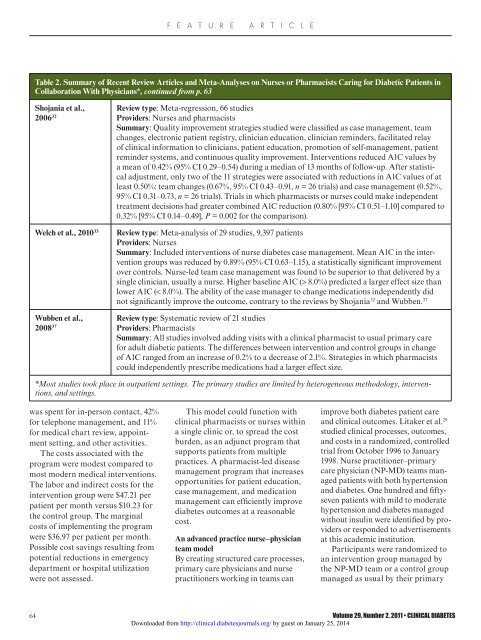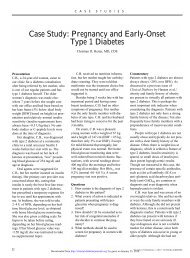Interdisciplinary Team Care for Diabetic Patients ... - Clinical Diabetes
Interdisciplinary Team Care for Diabetic Patients ... - Clinical Diabetes
Interdisciplinary Team Care for Diabetic Patients ... - Clinical Diabetes
Create successful ePaper yourself
Turn your PDF publications into a flip-book with our unique Google optimized e-Paper software.
F E A T U R E A R T I C L E<br />
Table 2. Summary of Recent Review Articles and Meta-Analyses on Nurses or Pharmacists Caring <strong>for</strong> <strong>Diabetic</strong> <strong>Patients</strong> in<br />
Collaboration With Physicians*, continued from p. 63<br />
Shojania et al.,<br />
2006 32<br />
Welch et al., 2010 33<br />
Wubben et al.,<br />
2008 37<br />
Review type: Meta-regression, 66 studies<br />
Providers: Nurses and pharmacists<br />
Summary: Quality improvement strategies studied were classified as case management, team<br />
changes, electronic patient registry, clinician education, clinician reminders, facilitated relay<br />
of clinical in<strong>for</strong>mation to clinicians, patient education, promotion of self-management, patient<br />
reminder systems, and continuous quality improvement. Interventions reduced A1C values by<br />
a mean of 0.42% (95% CI 0.29–0.54) during a median of 13 months of follow-up. After statistical<br />
adjustment, only two of the 11 strategies were associated with reductions in A1C values of at<br />
least 0.50%: team changes (0.67%, 95% CI 0.43–0.91, n = 26 trials) and case management (0.52%,<br />
95% CI 0.31–0.73, n = 26 trials). Trials in which pharmacists or nurses could make independent<br />
treatment decisions had greater combined A1C reduction (0.80% [95% CI 0.51–1.10] compared to<br />
0.32% [95% CI 0.14–0.49], P = 0.002 <strong>for</strong> the comparison).<br />
Review type: Meta-analysis of 29 studies, 9,397 patients<br />
Providers: Nurses<br />
Summary: Included interventions of nurse diabetes case management. Mean A1C in the intervention<br />
groups was reduced by 0.89% (95% CI 0.63–1.15), a statistically significant improvement<br />
over controls. Nurse-led team case management was found to be superior to that delivered by a<br />
single clinician, usually a nurse. Higher baseline A1C (> 8.0%) predicted a larger effect size than<br />
lower A1C (< 8.0%). The ability of the case manager to change medications independently did<br />
not significantly improve the outcome, contrary to the reviews by Shojania 32 and Wubben. 37<br />
Review type: Systematic review of 21 studies<br />
Providers: Pharmacists<br />
Summary: All studies involved adding visits with a clinical pharmacist to usual primary care<br />
<strong>for</strong> adult diabetic patients. The differences between intervention and control groups in change<br />
of A1C ranged from an increase of 0.2% to a decrease of 2.1%. Strategies in which pharmacists<br />
could independently prescribe medications had a larger effect size.<br />
*Most studies took place in outpatient settings. The primary studies are limited by heterogeneous methodology, interventions,<br />
and settings.<br />
was spent <strong>for</strong> in-person contact, 42%<br />
<strong>for</strong> telephone management, and 11%<br />
<strong>for</strong> medical chart review, appointment<br />
setting, and other activities.<br />
The costs associated with the<br />
program were modest compared to<br />
most modern medical interventions.<br />
The labor and indirect costs <strong>for</strong> the<br />
intervention group were $47.21 per<br />
patient per month versus $10.23 <strong>for</strong><br />
the control group. The marginal<br />
costs of implementing the program<br />
were $36.97 per patient per month.<br />
Possible cost savings resulting from<br />
potential reductions in emergency<br />
department or hospital utilization<br />
were not assessed.<br />
This model could function with<br />
clinical pharmacists or nurses within<br />
a single clinic or, to spread the cost<br />
burden, as an adjunct program that<br />
supports patients from multiple<br />
practices. A pharmacist-led disease<br />
management program that increases<br />
opportunities <strong>for</strong> patient education,<br />
case management, and medication<br />
management can efficiently improve<br />
diabetes outcomes at a reasonable<br />
cost.<br />
An advanced practice nurse–physician<br />
team model<br />
By creating structured care processes,<br />
primary care physicians and nurse<br />
practitioners working in teams can<br />
improve both diabetes patient care<br />
and clinical outcomes. Litaker et al. 29<br />
studied clinical processes, outcomes,<br />
and costs in a randomized, controlled<br />
trial from October 1996 to January<br />
1998. Nurse practitioner–primary<br />
care physician (NP-MD) teams managed<br />
patients with both hypertension<br />
and diabetes. One hundred and fiftyseven<br />
patients with mild to moderate<br />
hypertension and diabetes managed<br />
without insulin were identified by providers<br />
or responded to advertisements<br />
at this academic institution.<br />
Participants were randomized to<br />
an intervention group managed by<br />
the NP-MD team or a control group<br />
managed as usual by their primary<br />
64 Volume 29, Number 2, 2011 • CLINICAL DIABETES<br />
Downloaded from http://clinical.diabetesjournals.org/ by guest on January 25, 2014




